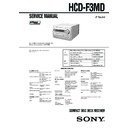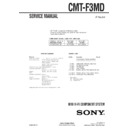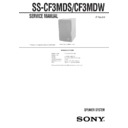Sony CMT-F3MD / HCD-F3MD Service Manual ▷ View online
3
ITEMS OF ERROR HISTORY MODE ITEMS AND CONTENTS
Selecting the Test Mode
Display
Details of History
E00
No error
E01
Disc error. PTOC cannot be read
(DISC ejected)
E02
Disc error. UTOC error
(DISC not ejected)
E03
Loading error
E04
Address cannot be read (Servo has deviated)
Table of Error Codes
Error Code
Error Code
Details of Error
total rec
Displays the recording time.
Displayed as “rssssssh”.
The displayed time is the total time the laser is set to the high power state.
This is about 1/4 of the actual recording time.
The time is displayed in decimal digits from 0h to 65535h.
Displayed as “rssssssh”.
The displayed time is the total time the laser is set to the high power state.
This is about 1/4 of the actual recording time.
The time is displayed in decimal digits from 0h to 65535h.
total play
Displays the play time.
Displayed as “pssssssh”. The time displayed is the total actual play time. Pauses are not counted.
The time is displayed in decimal digits from 0h to 65535h.
Displayed as “pssssssh”. The time displayed is the total actual play time. Pauses are not counted.
The time is displayed in decimal digits from 0h to 65535h.
retry err
Displays the total number of retries during recording and number of retry errors during play.
Displayed as “rss pss”.
“r” indicates the retries during recording while “p” indicates the retry errors during play.
The number of retries and retry errors are displayed in hexadecimal digits from 00 to FF.
Displayed as “rss pss”.
“r” indicates the retries during recording while “p” indicates the retry errors during play.
The number of retries and retry errors are displayed in hexadecimal digits from 00 to FF.
total err
Displays the total number of errors.
Displayed as “total ss”.
The number of errors is displayed in hexadecimal digits from 00 to FF.
Displayed as “total ss”.
The number of errors is displayed in hexadecimal digits from 00 to FF.
err history
Displays the 10 latest errors.
Displayed as “0s E@@”.
s indicates the history number. The smaller the number, the more recent is the error. (00 is the latest).
@@ indicates the error code.
Refer to the following table for the details. The error history can be switched by pressing the
Displayed as “0s E@@”.
s indicates the history number. The smaller the number, the more recent is the error. (00 is the latest).
@@ indicates the error code.
Refer to the following table for the details. The error history can be switched by pressing the
l
m
or
M
L
button.
er refresh
Mode which erases the “retry err”, “total err”, and “err history” histories.
When returning the unit to the customer after completing repairs, perform this to erase the past error history.
After pressing the
When returning the unit to the customer after completing repairs, perform this to erase the past error history.
After pressing the
[CD-MD SYNC]
button and “er refresh?” is displayed, press the
ENTER/YES “R”
button to
erase the history.
“Complete!” will be displayed momentarily.
Be sure to check the following when this mode has been executed.
• The data has been erased.
• The mechanism operates normally when recording and play are performed.
“Complete!” will be displayed momentarily.
Be sure to check the following when this mode has been executed.
• The data has been erased.
• The mechanism operates normally when recording and play are performed.
tm refresh
Mode which erases the “total rec” and “total play” histories.
These histories serve as approximate indications of when to replace the optical pick-up.
If the optical pickup has been replaced, perform this operation and erase the history.
After pressing the
These histories serve as approximate indications of when to replace the optical pick-up.
If the optical pickup has been replaced, perform this operation and erase the history.
After pressing the
[CD-MD SYNC]
button and “tm refresh?” is displayed, press the
ENTER/YES “R”
button to
erase the history.
“Complete!” will be displayed momentarily.
Be sure to check the following when this mode has been executed.
• The data has been erased.
• The mechanism operates normally when recording and play are performed.
“Complete!” will be displayed momentarily.
Be sure to check the following when this mode has been executed.
• The data has been erased.
• The mechanism operates normally when recording and play are performed.
E05
FOK has deviated
E06
Cannot focus (Servo has deviated)
E07
Recording retry
E08
Recording retry error
E09
Playback retry error
(Access error)
E0A
Playback retry error (C2 error)
Details of Error
4
TABLE OF CONTENTS
SELF-DIAGNOSIS FUNCTION
.....................................
2
1.
SERVICING NOTES
...............................................
5
2.
GENERAL
................................................................... 16
3.
DISASSEMBLY
......................................................... 18
4.
TEST MODE
............................................................... 26
5.
ELECTRICAL ADJUSTMENTS
MD Section ..................................................................... 30
CD Section ...................................................................... 38
CD Section ...................................................................... 38
6.
DIAGRAMS
6-1. Block Diagram – CD SERVO Section – ....................... 39
6-2. Block Diagram – MD SERVO Section (1/2) – ............. 40
6-3. Block Diagram – MD SERVO Section (2/2) – ............. 41
6-4. Block Diagram – MAIN Section – ................................ 42
6-5. Note for Printed Wiring Boards and
6-2. Block Diagram – MD SERVO Section (1/2) – ............. 40
6-3. Block Diagram – MD SERVO Section (2/2) – ............. 41
6-4. Block Diagram – MAIN Section – ................................ 42
6-5. Note for Printed Wiring Boards and
Schematic Diagrams ....................................................... 43
6-6. Printed Wiring Board – BD (CD) Board – .................... 44
6-7. Schematic Diagram – BD (CD) Board – ....................... 45
6-8. Schematic Diagram – BD (MD) Board (1/2) – ............. 46
6-9. Schematic Diagram – BD (MD) Board (2/2) – ............. 47
6-10. Printed Wiring Board – BD (MD) Board – ................... 48
6-11. Schematic Diagram – BD SW (MD) Board – ............... 49
6-12. Printed Wiring Board – BD SW (MD) Board – ............ 49
6-13. Schematic Diagram – LOADING (CD) Board – .......... 49
6-14. Printed Wiring Board – LOADING (CD) Board – ....... 49
6-15. Printed Wiring Board – MD DIGITAL Board – ........... 50
6-16. Schematic Diagram – MD DIGITAL Board – .............. 51
6-17. Printed Wiring Board – MAIN Board – ........................ 52
6-18. Schematic Diagram – MAIN Board (1/3) – .................. 53
6-19. Schematic Diagram – MAIN Board (2/3) – .................. 54
6-20. Schematic Diagram – MAIN Board (3/3) – .................. 55
6-21. Printed Wiring Boards – AMP/SP Boards – .................. 56
6-22. Schematic Diagram – AMP/SP Boards – ...................... 57
6-23. Printed Wiring Board – PANEL Board – ...................... 58
6-24. Schematic Diagram – PANEL Board – ........................ 59
6-25. Printed Wiring Board – POWER Board – ..................... 60
6-26. Schematic Diagram – POWER Board – ........................ 61
6-27. IC Pin Function Description ........................................... 70
6-7. Schematic Diagram – BD (CD) Board – ....................... 45
6-8. Schematic Diagram – BD (MD) Board (1/2) – ............. 46
6-9. Schematic Diagram – BD (MD) Board (2/2) – ............. 47
6-10. Printed Wiring Board – BD (MD) Board – ................... 48
6-11. Schematic Diagram – BD SW (MD) Board – ............... 49
6-12. Printed Wiring Board – BD SW (MD) Board – ............ 49
6-13. Schematic Diagram – LOADING (CD) Board – .......... 49
6-14. Printed Wiring Board – LOADING (CD) Board – ....... 49
6-15. Printed Wiring Board – MD DIGITAL Board – ........... 50
6-16. Schematic Diagram – MD DIGITAL Board – .............. 51
6-17. Printed Wiring Board – MAIN Board – ........................ 52
6-18. Schematic Diagram – MAIN Board (1/3) – .................. 53
6-19. Schematic Diagram – MAIN Board (2/3) – .................. 54
6-20. Schematic Diagram – MAIN Board (3/3) – .................. 55
6-21. Printed Wiring Boards – AMP/SP Boards – .................. 56
6-22. Schematic Diagram – AMP/SP Boards – ...................... 57
6-23. Printed Wiring Board – PANEL Board – ...................... 58
6-24. Schematic Diagram – PANEL Board – ........................ 59
6-25. Printed Wiring Board – POWER Board – ..................... 60
6-26. Schematic Diagram – POWER Board – ........................ 61
6-27. IC Pin Function Description ........................................... 70
7.
EXPLODED VIEWS
................................................ 80
8.
ELECTRICAL PARTS LIST
............................... 86
Notes on chip component replacement
• Never reuse a disconnected chip component.
• Notice that the minus side of a tantalum capacitor may be dam-
• Notice that the minus side of a tantalum capacitor may be dam-
aged by heat.
Flexible Circuit Board Repairing
• Keep the temperature of the soldering iron around 270 ˚C dur-
ing repairing.
• Do not touch the soldering iron on the same conductor of the
circuit board (within 3 times).
• Be careful not to apply force on the conductor when soldering
or unsoldering.
SAFETY-RELATED COMPONENT WARNING!!
COMPONENTS IDENTIFIED BY MARK
0
OR DOTTED
LINE WITH MARK
0
ON THE SCHEMATIC DIAGRAMS
AND IN THE PARTS LIST ARE CRITICAL TO SAFE
OPERATION. REPLACE THESE COMPONENTS WITH
SONY PARTS WHOSE PART NUMBERS APPEAR AS
SHOWN IN THIS MANUAL OR IN SUPPLEMENTS PUB-
LISHED BY SONY.
OPERATION. REPLACE THESE COMPONENTS WITH
SONY PARTS WHOSE PART NUMBERS APPEAR AS
SHOWN IN THIS MANUAL OR IN SUPPLEMENTS PUB-
LISHED BY SONY.
CAUTION
Use of controls or adjustments or performance of procedures
other than those specified herein may result in hazardous ra-
diation exposure.
other than those specified herein may result in hazardous ra-
diation exposure.
This appliance is classified as a CLASS 1 LASER product.
The CLASS 1 LASER PRODUCT MARKING is located on
the rear exterior.
The CLASS 1 LASER PRODUCT MARKING is located on
the rear exterior.
Laser component in this product is capable of emitting radiation
exceeding the limit for Class 1.
exceeding the limit for Class 1.
The following caution label is located inside the unit.
5
SECTION 1
SERVICING NOTES
The laser diode in the optical pick-up block may suffer electro-
static break-down because of the potential difference generated
by the charged electrostatic load, etc. on clothing and the human
body.
During repair, pay attention to electrostatic break-down and also
use the procedure in the printed matter which is included in the
repair parts.
The flexible board is easily damaged and should be handled with
care.
static break-down because of the potential difference generated
by the charged electrostatic load, etc. on clothing and the human
body.
During repair, pay attention to electrostatic break-down and also
use the procedure in the printed matter which is included in the
repair parts.
The flexible board is easily damaged and should be handled with
care.
For CD
NOTES ON LASER DIODE EMISSION CHECK
The laser beam on this model is concentrated so as to be focused
on the disc reflective surface by the objective lens in the optical
pick-up block. Therefore, when checking the laser diode emis-
sion, observe from more than 30 cm away from the objective lens.
on the disc reflective surface by the objective lens in the optical
pick-up block. Therefore, when checking the laser diode emis-
sion, observe from more than 30 cm away from the objective lens.
LASER DIODE AND FOCUS SEARCH OPERATION
CHECK
CHECK
Carry out the “S curve check” in “CD section adjustment” and
check that the S curve waveforms is output three times.
check that the S curve waveforms is output three times.
For MD
NOTES ON LASER DIODE EMISSION CHECK
Never look into the laser diode emission from right above when
checking it for adjustment. It is feared that you will lose your sight.
checking it for adjustment. It is feared that you will lose your sight.
CLEANING OBJECTIVE LENS OF OPTICAL PICK-UP
• In cleaning the objective lens of optical pick-up, be sure the
following below.
1. In cleaning the lens, do not apply an excessive force.
As the optical pick-up is vulnerable, application of excessive
force could damage the lens holder.
force could damage the lens holder.
2. In cleaning, do not use a cleaner other than exclusive cleaning
liquid (KK-91 or isopropyl alcohol).
3. Wipe the objective lens spirally from center toward outside.
(See Figure A)
NOTES ON HANDLING THE OPTICAL PICK-UP
BLOCK OR BASE UNIT
BLOCK OR BASE UNIT
MODEL IDENTIFICATION
— Back panel —
(Figure A)
4. Eject the disk, if loaded.
5. Disconnect the power cord from the socket to shut off the power
5. Disconnect the power cord from the socket to shut off the power
supply.
6. When cleaning the objective lens of optical pick-up in CD,
refer to “HOLDER (BU) ASS’Y” on page 24 for removing
HOLDER (BU) ASS’Y.
HOLDER (BU) ASS’Y.
PART No.
Model
Part No.
Hong Kong model
4-229-548-1[]
Korean model
4-232-128-0[]
Taiwan model
4-232-129-0[]
6
DRAWING OUT THE TRAY WHEN THE POWER IS OFF
CLEANING THE OPTICAL PICK-UP (CD PLAYER)
tray (CDM)
Move the cam block in the direction
of arrow
of arrow
A
with a finger.
A
CD mechanism deck
floating screw
(PTPWH M2.6)
(PTPWH M2.6)
optical pick-up block
Clean the lens block
with a cotton bud.
with a cotton bud.



